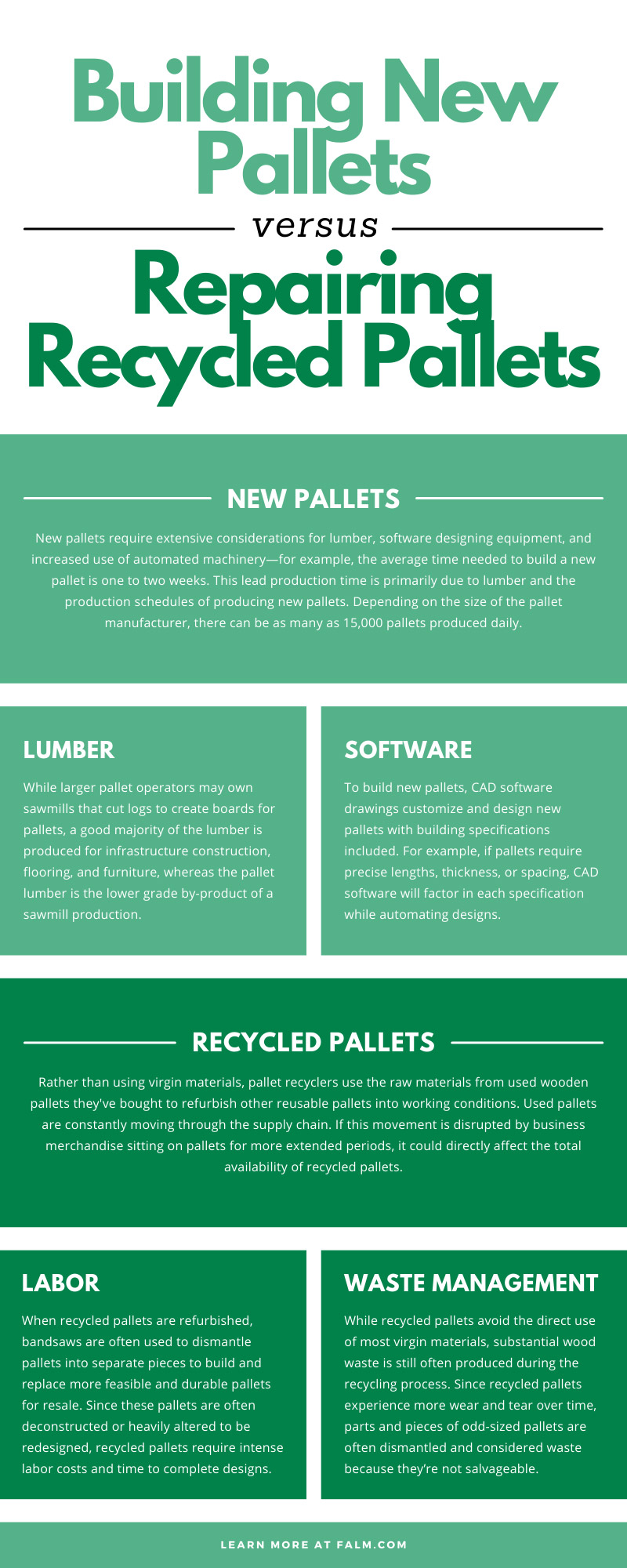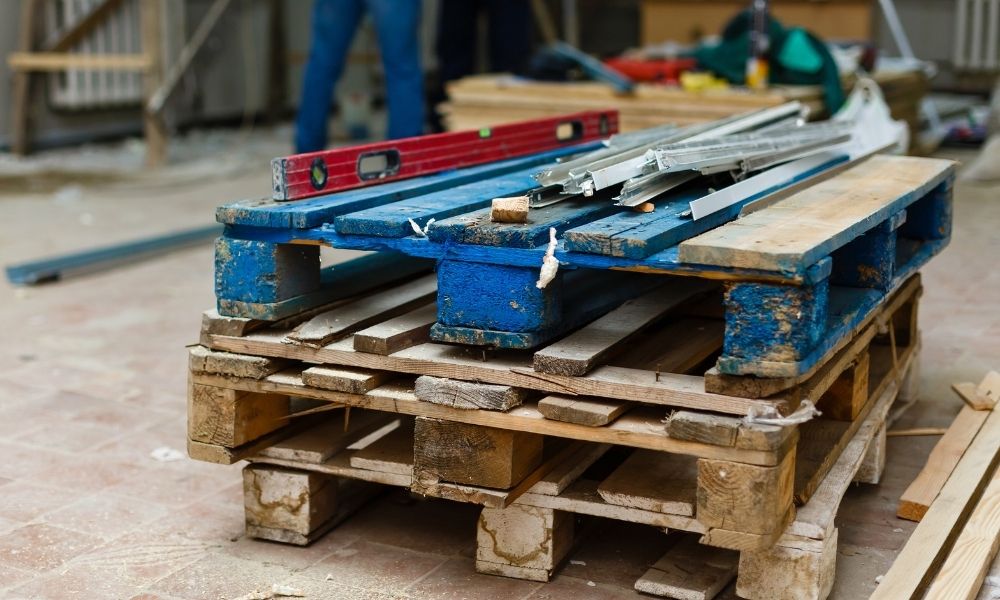All suppliers must decide between building new or recycled pallets. Each of these pallet types comes with different manufacturing processes.
While new pallets are incredibly capital intensive—with more significant investments requiring businesses to quickly pay the cost of lumber—recycled pallets are highly labor-intensive with more necessary hands-on refurbishing techniques. These are just some of the most significant comparisons between these two pallet types.
To learn more about the most significant differences between building new pallets versus pairing recycled pallets, continue reading our blog.
New Pallets
New pallets require extensive considerations for lumber, software designing equipment, and increased use of automated machinery—for example, the average time needed to build a new pallet is one to two weeks. This lead production time is primarily due to lumber and the production schedules of producing new pallets. Depending on the size of the pallet manufacturer, there can be as many as 15,000 pallets produced daily. Note that you can avoid longer lead times by making arrangements with your manufacturer to keep finished pallets in stock and ready for delivery. This is generally only an option for higher volume customers ordering at least once a week or someone who uses a standard size that the manufacturer already stocks.
Lumber
While larger pallet operators may own sawmills that cut logs to create boards for pallets, a good majority of the lumber is produced for infrastructure construction, flooring, and furniture, whereas the pallet lumber is the lower grade by-product of a sawmill production. Most pallet operators have to place lumber orders from other sawmills, and most do not harvest their own lumber. Since most sawmills require Net 10 payment terms for compensation, companies must rapidly pay for these resources.
Software
To build new pallets, CAD software drawings customize and design new pallets with building specifications included. For example, if pallets require precise lengths, thickness, or spacing, CAD software will factor in each specification while automating designs.
Automated Machinery
Nailing machines are also often used when building new pallets because this equipment is an effective and efficient method of automating the production process. Pallet builders may also use nail guns, but this tool yields slower results than automatic nailing machines.
The standard dimensions of a new pallet are 48×40; however, there are various sizes and types of pallets that businesses may need to customize. Builders may not use automatic nailing machines when a pallet is too small or too large to fit on a nailing machine. When pallet builders cannot use automatic nailing machines during pallet production, employee labor becomes much more intensive to build these materials hands-on.
However, the process of creating new pallets is ultimately a capital-intensive investment compared to employee labor. Time, management, and money toward acquiring materials, utilizing software, and managing machinery are the greatest expenses of this process.
Recycled Pallets
Recycled pallets also require certain investments. First, pallet recyclers must acquire recycled pallets at the endpoint of the supply chain.
Rather than using virgin materials, pallet recyclers use the raw materials from used wooden pallets they’ve bought to refurbish other reusable pallets into working conditions. Used pallets are constantly moving through the supply chain. If this movement is disrupted by business merchandise sitting on pallets for more extended periods, it could directly affect the total availability of recycled pallets.
Labor
When recycled pallets are refurbished, bandsaws are often used to dismantle pallets into separate pieces to build and replace more feasible and durable pallets for resale. Since these pallets are often deconstructed or heavily altered to be redesigned, recycled pallets require intense labor costs and time to complete designs. However, unlike new pallets, recycled pallets need less expensive tools and equipment to refurbish pallets. Rather than automated machines, recycled pallets are refurbished with pry bars, hammers, nail guns, and reciprocating saws. These pallets will ultimately require more time and money invested into labor compared to machinery.
Waste Management
While recycled pallets avoid the direct use of most virgin materials, substantial wood waste is still often produced during the recycling process. Since recycled pallets experience more wear and tear over time, parts and pieces of odd-sized pallets are often dismantled and considered waste because they’re not salvageable. If pallets are broken or otherwise deemed not worth dismantling, these materials are also considered waste products.
Businesses often grind the wood waste into mulch to generate use from the mass amounts of inevitable wood waste. This mulch is then sold as another form of a revenue stream to help enterprises cover pallet transportation and handling costs. For example, wood grindings and mulch are resold for landscaping, biofuel, and even for the manufacturing of press wood pallets.
Recycled Pallet Pricing
The pricing for wooden pallets is also vital to consider when examining the use of recycled pallets. The price of recycled pallets is based on the availability of pallets in need of repair, changes in pallet inventories, and locations of where pallets are ultimately transported. When manufacturers produce fewer new pallets, the buying and resale of recycled pallets are also directly affected. This market model must constantly be moving to avoid these shortages or blockages.
Storage Spaces for Recycled Pallets
In terms of space, recycled pallets often require more space for their production and storage compared to new pallets. While pallet recyclers store inventories of thousands, tens of thousands, and even hundreds of thousands of bulky pallets to refurbish, new pallets only need storage for lumber inventories.
Whether suppliers are building new pallets versus repairing recycled pallets, each of these methods requires different concentrations in costs borne by the supplier and passed down to customers. New pallet manufacturers will have higher capital costs in resources such as lumber and, as such, need to pay for lumber supplies to acquire these materials rapidly. New pallets must factor in the delivery of lumber supplies into their production time and increase the use of automated machinery to build pallets.
Recycled pallets will use less automated machinery and equipment and focus more on acquiring used pallets, paying labor to deconstruct pallets, and repurpose wood waste. Costs in transportation and storage space will also significantly impact the overall costs depending on these models.
Whenever working with pallets, it is useful to know the major differences between building new versus used wooden pallets. We hope highlighting these manufacturing processes has informed you of some of the key similarities and differences between these two pallet types.


